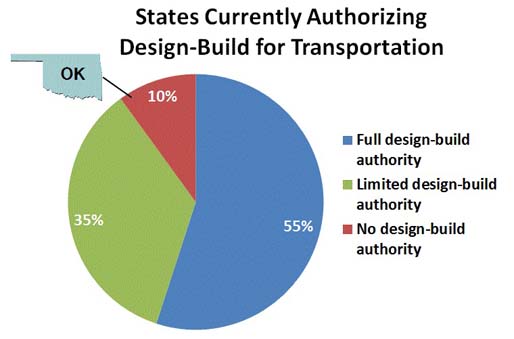by Richard Thomas | December 2, 2013
A couple weeks ago, I was able to fly to Oklahoma and make the case for design-build project delivery. Oklahoma is a state that has never been very open to design-build, but recently we’ve seen some real progress. Oklahoma State Representative Richard Morrissette introduced two bills in the 2013 legislative session that would expand design-build in the transportation sector, HB 1657 and HB 1669. By the end of the session, Morrissette was able to move them further than any other previous efforts in the state and get the legislature to do an interim session study on design-build and P3s.
Throughout the fall, Morrissette’s Legislative Assistant Jacklyn Brink-Rosen compiled information and invited industry experts from around the country to come testify before the House Transportation Committee, which was charged with conducting the interim study. Prior to the hearing, I began to work with Oklahoma DBIA members to get a lay of the land and begin the process of reaching out to other industry and owner stakeholders. We know that rallying support from industry and owners is a key element to legislative success. With that in mind, Steven Johnson of Cobb Engineering set up our first meeting with the new leadership at the DOT where we had open and frank discussions. We discussed the benefits of design-build, the reasons DOTs were using design-build and emerging trends in the industry. By the end of our meeting we felt that the first critical step – beginning the dialogue – had been a success.
I knew my testimony was likely to receive a more critical view. In the last session, design-build opponents put out a lot of misinformation in their efforts to block us. Many legislators mistakenly believed that design-build projects were not competitively bid, cost more, and that it was only used for big projects that would be awarded to out of state contractors. I was excited for the chance to dispel these common myths.
I began my presentation by telling committee members about DBIA and the design-build process. I carefully explained what design-build is and how it differs from the traditional design-bid-build method. It was critical for them to know that design-build had a very robust, competitive selection process.
One of the goals of my testimony was to convey the benefits of design-build; giving the committee both a federal and state perspective. Legislators are more open to new ideas and methods if they have succeeded in other states and at other levels of government. Hearing why other owners have decided to use design-build tends to be the critical juncture in any design-build hearing. I also showed the committee what trends were emerging in design-build, the growth in market share and the expansion of design-build authority in other states. This is also important because legislators want to be able to compete with their neighbors. Finally, I gave real examples of how design-build could be effectively applied in Oklahoma and what the key elements are to making the transition to design-build.
With the presentation complete, I eagerly waited for the grilling to begin. The Q & A portion is my favorite part of every hearing and it is often the most revealing. My two favorite questions were, “Why is design-build allowed on building projects but not on transportation projects?” and “If design-build is so good, why do people oppose it?” These two questions really get to the heart of the problem in Oklahoma. The lack of design-build authority in Oklahoma is not a performance problem, it is a political problem. The design-build project delivery method has demonstrated that it works very well on all types of projects all over the country. The only reason it is not fully authorized for all sectors is due to the raw political power of special interests that benefit from the old way of doing business.
During the remainder of the day, I took individual legislators aside to address the questions they might have and one legislator said to me, “I am just a simple farmer but, from what I have heard, all the benefits of using design-build benefit the general public. And all the criticisms that I have heard about design-build come from industry trying to protect their turf.” I smiled and said, “I think you get it.” The design-build legislative effort is just beginning, but clearly we are at least one vote closer to passage.

